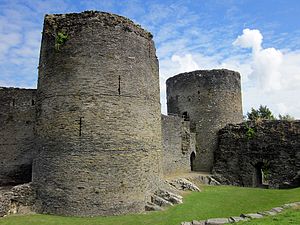Cilgerran Castle
| Cilgerran Castle | |
|---|---|
|
Cilgerran Castle |
|
| Creation time : | 12th century |
| Castle type : | Spurburg |
| Conservation status: | Castle ruins |
| Standing position : | Aristocratic residence |
| Place: | Cilgerran |
| Geographical location | 52 ° 3 '26 " N , 4 ° 38' 3" W |
Cilgerran Castle is a medieval castle near Cardigan in the county of Pembrokeshire in Wales . The castle, of which only a ruin remains, was built in the 12th century and is now owned by the National Trust .
history
The first fortification at this point was a motte , i.e. a castle made of wood, which was probably built around 1100. Possibly this is the castle Cenarth Bychan , which Gerald of Windsor , the Anglo-Norman constable of Pembroke Castle , had built and which has not yet been clearly located. Cilgerran Castle may also have been the castle from which Owain ap Cadwgan , Prince of Powys , kidnapped Gerald de Windsor's wife Nest ferch Rhys and their children in 1109 , causing years of armed conflict.
Cilgerran Castle was first mentioned in 1165, when Lord Rhys , a ruler of the South Welsh principality Deheubarth , took the castle. In 1204, William Marshal, 1st Earl of Pembroke , an Anglo-Norman knight and Lord Marshal of England , conquered the castle. In 1215, the Welshman Llywelyn the Great , Prince of Gwynedd , occupied the complex during his campaigns of conquest in the south of Wales. In 1223, however, William Marshal, 2nd Earl of Pembroke, was able to recapture the castle and expand it in its current form. In 1257, the Welsh failed to try again to take the castle.
In the second half of the 13th century, after the last male marshal died, the castle came into the possession of the de Cantelupe family and later the Hastings family through marriage. However, little was invested in maintaining the castle, so that it slowly fell into disrepair. It was not until 1377 that King Edward III. Repair and expansion work to counter an impending French invasion. In 1389 the castle fell to the crown as the Hastings family had no male heir. Around 1400 the fortification gained even greater importance when Owain Glyndŵr , a Welsh national hero, led a struggle for independence against England with French support.
Cilgerran Castle was later left by King Henry VII to the Vaughan family, who lived there until they moved into a newly built property nearby in the early 17th century. In the 18th and 19th centuries the castle complex fell into disrepair and became a ruin. In 1938 the then owner, Sir Lewes Pryce, left Cilgerran Castle to the National Trust.
investment
Cilgerran Castle is located on a rocky headland between the Teifi River and the flowing Plysgog. Since the Teifi reaches its tidal limit here , the castle was a natural crossing point and transit point for seagoing ships. The headland is protected by two ditches on the open side.
Major parts of the complex go back to William Marshal, 2nd Earl of Pembroke . The first moat includes a bailey with the remains of a gatehouse. The collapse of the building was caused by the mining of slate in the 19th century. Behind the outer defenses, another moat surrounds the courtyard, which William Marshal had fortified with two large towers and a massive gatehouse. Medieval castles, on the other hand, usually only have a high tower in the middle of the castle. A drawbridge gave access to the three-story gatehouse. There was a small room above the gate, possibly a chapel. Above it was a passage with slit windows that connected the gatehouse to the two round towers in the east. On top of the wall there was a battlements and a second access path to the towers.
Both towers have a ground floor and three upper floors, the position of which can be seen through the beam holes for the wooden floors and the chimneys. Access to the east tower was via a spiral staircase inside the tower. The ground floor room had a separate entrance. Access to the higher floors was probably through trap doors. The west tower originally had an entrance on the first floor via a staircase from the courtyard. Here, too, access to the upper floors was via trap doors. The Sally port, consisting of a door through the wall next to the east tower and another through the wall of the outer bailey, gave the defenders the opportunity to fall in the back of the attackers.
The inner courtyard was surrounded by a wall several meters thick with slotted windows and a battlement. The walls inside the castle were considerably thinner and had windows. The buildings along the north-east and north-west sides of the courtyard probably date from the second half of the 13th century. It was probably a hall and private apartments. A kitchen was against the west wall. There was a third tower at the southwest end of the complex. Under King Edward III. the weir system was expanded further. Several buildings in the castle courtyard were added and a D-shaped north tower was built. The castle now resembled Pembroke Castle in its layout .





